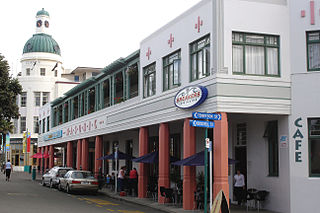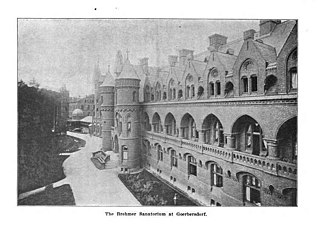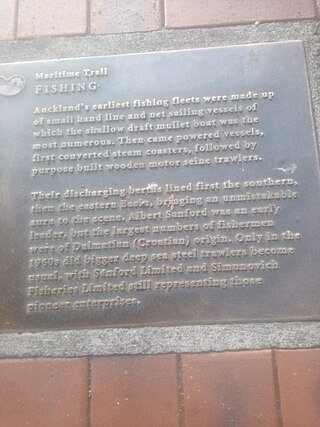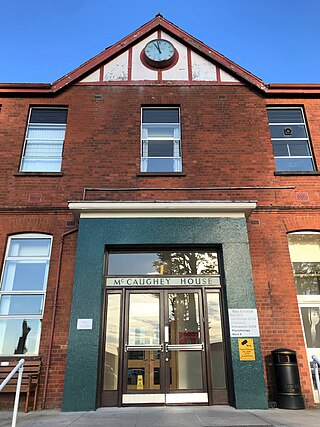
Hawke's Bay is a region on the east coast of New Zealand's North Island. The region is named for Hawke Bay, which was named in honour of Edward Hawke. The region's main centres are the cities of Napier and Hastings, while the more rural parts of the region are served by the towns of Waipukurau, Waipawa, and Wairoa.

Napier is a city on the eastern coast of the North Island of New Zealand and the seat of the Hawke's Bay region. It is a beachside city with a seaport, known for its sunny climate, esplanade lined with Norfolk pines, and extensive Art Deco architecture. Napier is sometimes referred to as the "Nice of the Pacific", although that is largely outdated and a more common nickname is 'The Art Deco Capital of the world'.
Waipukurau is the largest town in the Central Hawke's Bay District on the east coast of the North Island of New Zealand. It is located on the banks of the Tukituki River, 7 kilometres south of Waipawa and 50 kilometres southwest of Hastings.

A sanatorium, also sanitarium or sanitorium, is a historic name for a specialised hospital for the treatment of specific diseases, related ailments, and convalescence. Sanatoriums are often in a healthy climate, usually in the countryside. The idea of healing was an important reason for the historical wave of establishments of sanatoria, especially at the end of the 19th and early 20th centuries. One sought, for instance, the healing of consumptives especially tuberculosis or alcoholism, but also of more obscure addictions and longings of hysteria, masturbation, fatigue and emotional exhaustion. Facility operators were often charitable associations, such as the Order of St. John and the newly founded social welfare insurance companies.

Taradale is a suburb of the City of Napier, in the Hawke's Bay Region of the North Island of New Zealand. It is a predominantly middle-upper class residential suburb, located 10 kilometres southwest of the centre of Napier. The Taradale ward, which includes Greenmeadows, Meeanee, and Poraiti, had a population of 22,809 in the 2018 New Zealand census.

Sunland Hospital refers to a chain of state schools located throughout the state of Florida.

Henryton State Hospital is a now-demolished hospital complex in Marriottsville, in southern Carroll County, Maryland, just across the Howard County line. The complex was located within Patapsco Valley State Park and along its southern end runs CSX's Old Main Line Subdivision and is very close to the Henryton Tunnel. The Henryton State Hospital center, or the Henryton Tuberculosis Sanatorium as it was called, was erected in 1922 by the Maryland Board of Mental Hygiene. It was established as a facility to treat African Americans suffering from tuberculosis. This was one of the first such facilities in Maryland erected to provide African Americans with the same level of treatment as white people. Other accounts state that this was more of containment Hospital rather than a treatment facility. They contend that Henryton was used more for the exile and quarantine of tuberculosis patients.

John Kenneth Buck is chairman of Te Mata Estate winery and is widely recognised for his contributions to fine wine and the New Zealand wine industry.

Croatian New Zealanders refers to New Zealand citizens of Croatian descent. It is estimated that over 100,000 New Zealanders have Croatian ancestry. There are 2,550 people who declared their nationality as Croats in the 2006 New Zealand census. The majority of these are located primarily in and around Auckland and Northland with small numbers in and around Canterbury and Southland.

Hawkmoor Hospital, originally known as Hawkmoor County Sanatorium, was a specialist hospital near Bovey Tracey in Devon, England, founded in 1913 as a pulmonary tuberculosis sanatorium as part of a network of such facilities, instigated by the Public Health 1912. From 1948, the hospital catered for patients with a range of chest ailments, as well as chest surgery, and mental disability patients. From 1973, the facility dealt solely with mental health problems until its closure in 1987.

Thomas Harcourt Ambrose Valintine was a New Zealand medical doctor and public health administrator, who spent the first three decades of the 20th century dedicated to public health. He was responsible for major tuberculosis treatment initiatives in New Zealand, the introduction of district nursing and a pioneering health education campaign.

The Indian hospitals were racially segregated hospitals, originally serving as tuberculosis sanatoria but later operating as general hospitals for indigenous peoples in Canada which operated during the 20th century. The hospitals were originally used to isolate Indigenous tuberculosis patients from the general population because of a fear among health officials that "Indian TB" posed a danger to the non-indigenous population. Many of these hospitals were located on Indian reserves, and might also be called reserve hospitals, while others were in nearby towns.
Government Hospital of Thoracic Medicine, popularly known as the Tambaram TB Sanatorium, is a major state-owned hospital situated in Chennai, India. The hospital is funded and managed by the state government of Tamil Nadu. It was founded in 1928.
The town of Colorado Springs, Colorado, played an important role in the history of tuberculosis in the era before antituberculosis drugs and vaccines. Tuberculosis management before this era was difficult and often of limited effect. In the 19th century, a movement for tuberculosis treatment in hospital-like facilities called sanatoriums became prominent, especially in Europe and North America. Thus people sought tuberculosis treatment in Colorado Springs because of its dry climate and fresh mountain air. Some people stayed in boarding houses, while others sought the hospital-like facilities of sanatoriums. In the 1880s and 1890s, it is estimated that one-third of the people living in Colorado Springs had tuberculosis. The number of sanatoriums and hospitals increased into the twentieth century. During World War II, medicines were developed that successfully treated tuberculosis and by the late 1940s specialized tuberculosis treatment facilities were no longer needed.

The Oregon State Tuberculosis Hospital was a tuberculosis sanatorium in Salem, Oregon, United States. Established in 1905, it was the first public tuberculosis sanatorium on the West Coast. The main hospital building, constructed in 1894, had formerly housed the Oregon State Deaf-Mute School. After its conversion into the state tuberculosis hospital, multiple cottages and additional buildings were constructed on the property. The hospital remained in operation until 1969, when it was purchased by Corban University.

The Firland Sanatorium was Seattle's municipal tuberculosis treatment center. It opened on May 2, 1911, and closed on October 30, 1973.

Forster Green Hospital was a non-acute hospital located in Belfast, Northern Ireland. It offered a range of services including neurology, care of older people, and a child and family centre. The hospital was located on a 47-acre site in South Belfast. It was managed by the Belfast Health and Social Care Trust and closed in 2012. Located within the hospital grounds is the regional child and adolescent mental health inpatients unit, Beechcroft. This opened in 2010. Knockbreda Wellbeing and Treatment centre is also located within the grounds of Forster Green and opened in 2009. This has been described as a "one stop approach" to healthcare as it offers a wide range of healthcare services for the local community including general practice and physiotherapy.

The Hawke's Bay wine region is New Zealand's oldest and second-largest wine-production region, on the east coast of the North Island. Production reached 41,000 tonnes in 2018 from 4,681 hectares of planted vines, representing 10.2% of total national production. Some of the oldest wineries still operating in New Zealand, including Te Mata Estate, Church Road, and Mission Estate, were established in the Hawke's Bay area in the late 19th century. Despite this, it was only established as a geographical indication (GI) in 2018. The GI protects any wine produced within the boundaries of the entire Hawke's Bay Region, but in practice the vineyards are chiefly concentrated in the plains and low hills surrounding the cities of Napier and Hastings.

Whiteabbey Hospital is a hospital located close to the village of Whiteabbey, within the town of Newtownabbey, Northern Ireland. The hospital first opened in 1907 as The Abbey Sanitorium, centred around a country house known as 'The Abbey'. The house has stood on the site from 1850, and was once the residence of prominent architect Charles Lanyon. The hospital was extended and several buildings added throughout the early 20th century, and it was renamed Whiteabbey Hospital in 1947. The hospital is managed by the Northern Health and Social Care Trust. Many healthcare services have been withdrawn from the hospital, most recently with the closure of the Minor Injuries Unit in 2014.

Mission Estate Winery is New Zealand's oldest surviving winemaking concern, first established in the Hawke's Bay in 1851 by French Catholic Marist missionaries for producing sacramental wine. It is one of the largest wineries in the Hawke's Bay and remains wholly New Zealand owned.



















